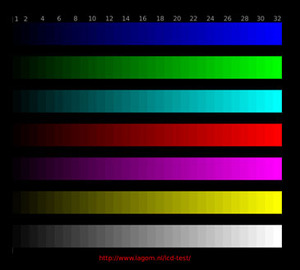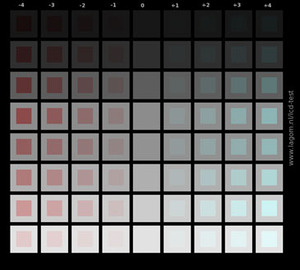Objective Image Quality Analysis
There is a wide range of image quality testing applications and resources available today. One of our current favourites can be found over at Lagom. Detailed tests for everything from colour gradients to gamma calibration and pixel response are included along with a detailed guide to interpreting what you are seeing.Before we get onto how the HannsG HG221AP performs in our tests though, it's worth talking about the colour profiles offered in the display's OSD – there are four options in total: Warm (9,300K), Nature (6,500K) and Cool (5,500K) and User. On the whole, we found that the automatic modes were OK, but the lack of an sRGB profile was disappointing – we found ourselves using the user mode to manually adjust the red, green and blue colour channels.
After some tweaking, we were quite pleased with what we had achieved because not only were the colours relatively vibrant, but they were also fairly well defined. Sure, they're never going to come close to what you can achieve with a professional monitor like NEC's MultiSync LCD3090WQXi for example, but they're a damn sight better than a lot of the mediocrity we've seen on other 22-inch TN+Film displays.
The HG221AP also includes dynamic contrast adjustments under the guise of X-Contrast – when enabled, this disables manual brightness and contrast controls. It's a very subtle effect, and while we'd praise a dynamic contrast ratio implementation for being subtle, we found that it was still an incredibly blunt instrument – we'll talk about this more when we look at some of the more real-world test scenarios we put the display through.
In the contrast tests, the HG221AP performed admirably even using its default colour – this is unlike most other TN+Film panels where they either lose detail or vibrancy in order to maintain respectable colour accuracy. Admittedly, the blacks are a little weak in the Blues and Reds in particular, but they're by no means awful.
This was further confirmed when we tested the display's black levels – we could make out box four, but both boxes one, two and three were not visible with maximum brightness. White saturation was a similar story too – box 251 was very visible, 252 barely visible, while both 253 and 254 were essentially invisible without adjusting the contrast, which in turn sacrificed either colour vibrancy, colour accuracy or both.
Probably most impressive of all was the gradient banding test – there were no visible signs of banding anywhere along the gradients although there was a slight hint of pink in the mid tones. That's nothing to worry about on the grand scheme of things.
What did worry us a little though was the display's susceptibility to pixel walk or inversion – we adjusted the clock and phase timings until they didn't cause flicker in the clock phase test, but even after doing that there was still a lot of pixel walk in a number of the tests. While these tests are a little extreme and are designed to really highlight instances where inversion or pixel walk can take place, they can translate into 'pixel walk' problems with certain colours – this could be an annoyance for anyone susceptible to flicker.
Response times were reasonable, but we did notice some minor ghosting in the black-to-white transitions – they were nothing to get upset about though and this display behaved very much like you'd expect a 5ms TN+Film to behave. The story surrounding viewing angles was very much the same as the response time – the HG221AP performs the same as any other TN+Film panel. It's worth noting here that there is a bit of vertical colour inversion looking straight on, but nothing that will magically disappear on any other 22-incher.

MSI MPG Velox 100R Chassis Review
October 14 2021 | 15:04













Want to comment? Please log in.